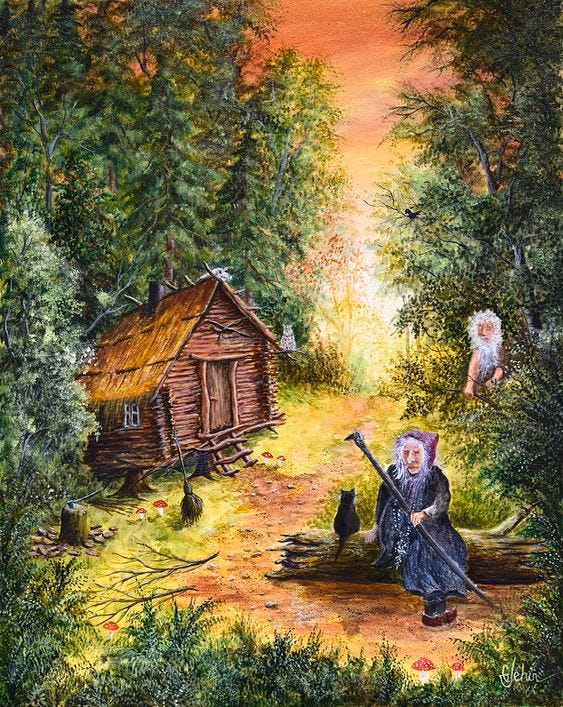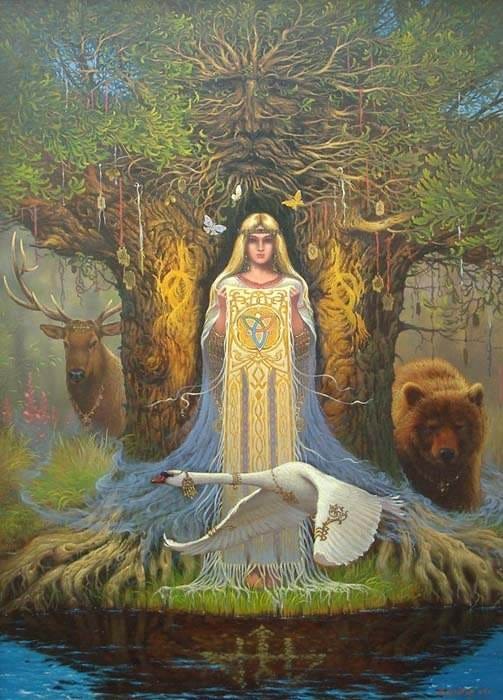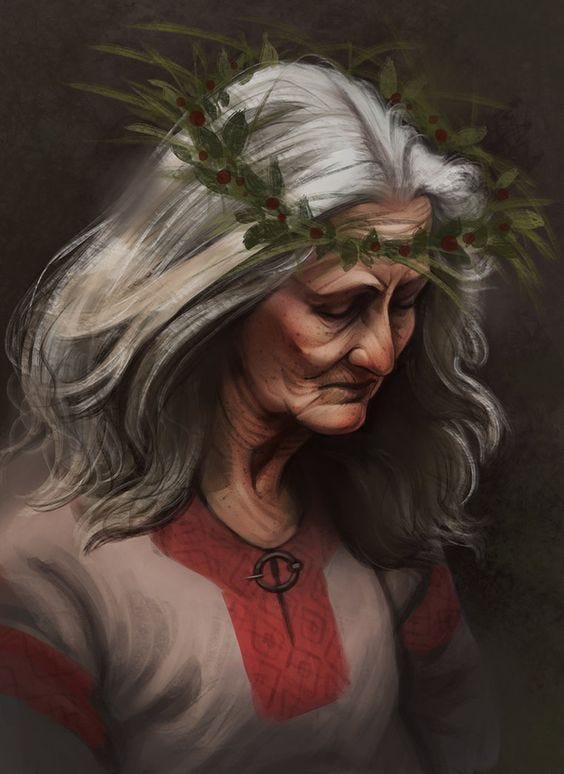Berkana - Baba Yaga - The Ancient Mother
Today’s pickings Dear Reader, After week-long research, I bring to you the full version of the most awaited ‘real' story of Baba Yaga. If you missed the introductory post, then I recommend you to visit here for a full understanding of this exciting narrative. Without much ado, let’s dive right into the story. The dark is not a fearful place. It is a place of reflection, rebirth, and redemption. The metaphorical womb, traveling through whose canals, propels one to re-emerge into a new form. When a seed is buried deep in the darkness of the cold earth, what might look like a moment of suffering for the seed, is a nurturing place of rest. In the womb of Mother Earth, the seed is gently encouraged to grow roots and stem. In this cradle of darkness, the seed is awakened to all the epiphanies of life. Away from the bright luminous extravaganza of nature, the seed learns the secrets of life in its restful fetal sleep. The void from which life emerges is the negative space of the feminine. Negative is often misinterpreted as bad, however, it simply means ‘in absence of’. The feminine is the negative force of nature because the feminine is the space of receptiveness and creation. It is an emptiness of matter that holds the ultimate truth of birth. What helps the seed to crack out of its shell, is the absence of competition around it or the presence of space around it. The seed does not feel agitated encircled by the space, it feels no fear. Exposure to light and humidity too early will kill the seed. So it awaits its birth in the warmth and encouragement of the dark earth. Feel no fear of the dark. For life to take root, darkness is necessary. Due to the polar existence of nature, everything can be held within this paradox of duality. Archetypes that guide our impression of the world and inner psychological rifts also inherently contain such duality. The feminine archetypes are also split into these two extremes. The light and the dark, the constructive and destructive, the beginning and the end. Life emerges successfully only when both the aspects are married together. However, humans naturally tend to inhibit any direct association with the dark, especially the feminine. With the advent of Christianity, such interplay of duality was pushed even further away from our acceptance. Gradually, the dark feminine side that was considered sensuous, instinctive, earthy, and intuitive, started to be perceived as evil because it challenges the typical. The dark feminine was feared and eventually scraped out from the fabric of western mythology, leaving behind only the image of the virgin mother, under the halo of heavenly light, in the center stage of the Roman-occupied and influenced territories of the west. The power of the church dictated its strength across the west, and the East slowly moved wistfully to its promises of national unification under one religion. The time was coming to decapitate the sensual, earthy mother, to arrest her in the obscure sites of the psyche, and declare her abominable. Thus she became an esoteric musing of the unreconciled and forgotten past. The War of ReligionThe territory of East Slavic, Baltic and Finnic people (also known as Kievan Rus) used to be a cultural cocktail of several native belief systems. It remained outside of the territory of the patriarch Tzars of the Rus’ (Russia) for several hundred years. But year 988 had up its sleeves, a significant cultural shift. The Grand Prince of Kyiv, Vladimir I, also known as Vladimir the Great, was the first Tzar emperor who popularised Christianity in the Kievan Rus’. However, ironically, his vices seemed the furthest thing from the Arthurian ideals. If you knew about his cruel and deviant ways, you would be sure that this is the last man who would advocate Christianity. However, under the influence of his grandmother Olga, the power-hungry Vladimir was getting inclined towards the idea of uniting Rus under one religion. Olga was an influential woman who got baptized by one of the missionaries personally sent by the German king Otto I. And thus cast an eternal shadow on the future of the native people all over the Eastern territories. Not only were they were now at risk of losing their independent cultural practices, but they were also at the juncture of losing, perhaps forever, their connection with the wilderness. Eventually, the East Slavic, Baltic, and Finnic people were culturally assimilated under the church. Some of them who were Nomadic (like the Nenets), were forced to settle in one place, get systematic state governed education and contribute to the economy as a part of the Russian revolution. This led to the loss of people with their land and culture. A scar that still transpires in Russia’s relationship with her neighbors. One such lost connection led to the lesser-known misinterpretation of the myth of Baba Yaga. My focus in this post will be on tracing the lost connection and using language as the key to deciphering the cultural conundrum that seemed to surround the mystery of most origin stories. Language is an essential map that can directly connect people to places. The evolution of language shows us the traversal of our ancestors across the face of the Earth. It helps us understand who our ancestors met, sat across the table with, and shared their neighborhood. Language is the cultural magnifying glass used to examine the past through pragmatism rather than preconceptions. While studying the etymology of Baba Yaga, I practically went down a fascinating rabbit hole. As I ventured deep, I realized that the scholars have been bickering about the etymology of Baba Yaga for a very long time now. Baba Yaga was the problem child of both linguists and cultural historians. Baba in old Russian might mean a lot of things like midwife, sorceress, or fortune teller. Another origin could be the word babushka (grandmother). The word Baba also has a pejorative connotation (relating to women or feminine qualities) in modern Russian. This, many linguists suggest, is a result of taboos that the old Slavs used to associate with the word. ‘Yaga’ is believed to be etymologically more problematic as the scholars never seem to agree on one origin. Alexander Afanasyev proposed the word is a derivation of Proto-Slavic ož and Sanskrit ahi ('serpent’). By the 20th century, a lot more suggestions of derivation arose, some of which are, Serbo-Croatian jeza ('horror', 'shudder', 'chill'), Slovene jeza ('anger'), Old Czech jězě ('witch', 'legendary evil female being'), modern Czech jezinka ('wicked wood nymph', 'dryad'), and Polish jędza ('witch', 'evil woman', 'fury’). Indo-European sources suggested ‘iaga’ is the root that is linked to Lithuanian engti ('to abuse (continuously)', 'to belittle', 'to exploit'). So who was Baba Yaga? Was she an old wicked forest nymph, was she a furious and angry goddess, was she an old woman who sells herbs and potions, was she a mother protector who was constantly abused and exploited, or was she a devil incarnate who exists just to feed on horrors of human existence? No one knows. All we know for sure is that she is a woman, and she is dangerous. In some theories, it is believed that Baba Yaga was initially called Baba Yoga. It is believed that the word “yoga” came from the Sanskrit root yoj, which has many semantic meanings: “connection”, “unity”, “connection”, “harmony”, “union”, “exercise”, “curb”, etc. “Yagya” or “yaga” (with emphasis on “I”) in Hinduism is the traditional offering of gifts to the gods through fire. As the scholars now believe that the old Uralic language family (a derivative of which were spoken by many north Russian tribes) is closer to old Sanskrit, the above association makes a lot more sense. To prove this hypothesis true, I referred back to the work of Russian scientist and academician AI Sobolewski. He provided a list of Russian water bodies with Sanskrit names. In his article ‘The Names of the Rivers and Lakes of the Russian North’, he gives the names of the following rivers and lakes: Vaja (from vaja - strength), Valga (from Valgu - simple), Ira (a refreshing drink), Karak (karaka - water jar), Cala (black), Lala (lal - play), Padma (lotus), Punk (silt), Sagara (ocean), Sarah (sara - juice), Sukhona (suhana - easy) and Harina (goose). It proves that many of my ancestors were living in close proximity with the Proto-Indo-European people who then used to discuss the idea of God over coffee. And for whom, the Gods were present in the natural world and its natural elements which were instrumental in survival and thus revered. The possible origin storyAs some theories suggest, Baba Yaga stories have originated with their roots deep into ancient Slavic mythology. There used to worship a goddess called Yaga (the old Nentsy word Yaha means water or river). This fact is echoed in many variations of the Baba Yaga stories as in most versions, the old woman’s hut always seems to stay on the riverside. In Northern Russia, many stone statues called yagas or golden babas, exist sporadically across the landmass. These statues were believed to be of a local goddess who is asked for advice and who was believed to be empowered with deciding about the fate of people. Many of them will often have their own little 'huts' built on tree stumps and with lots of gifts. This reminds one of the sacred ceremonial offering sites of the Nenets known as Severn Chums. What we see here is a very strange phenomenon. The old woman of the folklore who is the most dreadful is a direct mirror image of an unknown ancient Slavic goddess. The resemblance in the stories was uncanny. This led me to look further for the image of the Slavic Goddess who was missing from the common psyche and how did such erasure happen. In his book ‘Slavic Faith: Deities & Commandments’ Dmitriy Kushnir bridges this gap between the origin myth and the derivative legends in the following story.
Connection with the Natural worldIt is hard to ignore the fact that the old Slavic ceremonial traditions might have appeared as an unusual practice to the eyes of a foreigner, who perhaps would have then proliferated only half-truth. These storytellers were not the people who understood the special rites of the indigenous lands. When the majority of Europe was proliferating under the security of the Virgin Mary, here was the Crone who conducts dangerous fire rites. Such a bold expression of femininity would have been both shocking and terrifying at the same time. The disintegration of the story from its land made it seem stranger than any fiction. Since only half-truth was told by fearful minds, the mother archetype got deconstructed into her dark and devouring role. When her narrative is separated from the land and the people that she belonged to, she looked like a strange god with unclear intentions. Without the natural elements of fire, earth, air, and mountains informing her action, the great Mother slowly turned into an evil witch who eats children. Therefore, this story is as much of a devil woman as it is of a pure goddess of light. This is a story of duality of the Mother Nature and man’s disconnection with the naturally occurring wild side of the feminine. It is a story of the mysterious, writhing, dark and dangerous part of the feminine world metaphorically represented by the depth of the rainforest and tundras of North-Eastern Europe. The challenging natural world and the fear of those challenges have led men to disconnect from the beauty of creation and create a cage forged out of fear to protect their psyche from imminent threats. Therefore Baba Yaga is one of those very rare archetypes who confronts one in the depth of their psychological forest (isolation) and asks them to come inside and help her. She wants to challenge one to examine one's virtues, to mirror one's vices. That is why she is only as dangerous as one deserves, and if one has lived and worked in unison with all the natural forces of nature and revered nature’s bountiful abundance, it is almost certain that just like Vasilisa the Beautiful, one will receive an eternal fire from Baba Yaga to light one's path and burn all their troubles away. Literary Application of the ArchetypeTaisia Kitaiskaia, a Russia born American writer, invoked the old Slavic witch and used her unique experience of integrating the archetype, in her book ‘Ask Baba Yaga: Otherworldly Advice for Everyday Troubles’. She chimes about her association with the archetype, “Born in eastern Russia, I spent the first five years of my life in the woods of Lake Baikal, and Baba Yaga lived there, too. I felt her among the mushrooms and berries and animals; I imagined her sitting in the dark of her hut, knitting something wily and strange. Around her head, she wore a kerchief, like any Russian grandmother, and she did feel like a grandmother to me—formidable and unpredictable, sure, but ultimately nurturing and wise.” Initially, her work was to weave witty advice in the voice of Baba Yaga for the advice column of the site called The Hairpin. However, the whole series eventually converted into a book. Taisia, in her poetic musings, attempted to answer all the difficult questions on love, belonging, and purpose. Here is an example of her Tanka style epiphanies and wisdom.
|
Older messages
Baba Yaga - for the Troubled and the Twisted
Sunday, February 13, 2022
A Misunderstood Archetype
Holy Contraptions - A Reverie for Obsolete Kitchen Tools
Saturday, February 5, 2022
And the woman who used them
Riders of the Tempest - A series
Saturday, January 29, 2022
N°1 | Onake Obavva | The Pestle Warrior
Priestesses and Prostitutes
Saturday, January 22, 2022
A Life Spent in Servitude
Priestesses and Prostitutes - The Forgotten Tales of Devadasis
Saturday, January 8, 2022
An Introduction
You Might Also Like
2025 Personal Development Goals 🎓
Friday, December 27, 2024
New year, new goals? ͏ ͏ ͏ ͏ ͏ ͏ ͏ ͏ ͏ ͏ ͏ ͏ ͏ ͏ ͏ ͏ ͏ ͏ ͏ ͏ ͏ ͏ ͏ ͏ ͏ ͏ ͏ ͏ ͏ ͏ ͏ ͏ ͏ ͏ ͏ ͏ ͏ ͏ ͏ ͏ ͏ ͏ ͏ ͏ ͏ ͏ ͏ ͏ ͏ ͏ ͏ ͏ ͏ ͏ ͏ ͏ ͏ ͏ ͏ ͏ ͏ ͏ ͏ ͏ ͏ ͏ ͏ ͏ ͏ ͏ ͏ ͏ ͏ ͏ ͏ ͏ ͏ ͏ ͏ ͏ ͏ ͏ ͏ ͏ ͏ ͏ ͏ ͏ ͏ ͏
The Weekender, December 27, 2024
Friday, December 27, 2024
The last one of the year
Closes Tonight • New Year's Day Newsletter Promo for Authors ●
Friday, December 27, 2024
Book Your Spot Now in Our New Year's Day Holiday Books Email Newsletter ! Book Your Spot in Our New Year's Day Email Newsletter Enable Images
🧙♂️ "Maybe next year will be different..."
Friday, December 27, 2024
How many times have you told yourself that? ͏ ͏ ͏ ͏ ͏ ͏ ͏ ͏ ͏ ͏ ͏ ͏ ͏ ͏ ͏ ͏ ͏ ͏ ͏ ͏ ͏ ͏ ͏ ͏ ͏ ͏ ͏ ͏ ͏ ͏ ͏ ͏ ͏ ͏ ͏ ͏ ͏ ͏ ͏ ͏ ͏ ͏ ͏ ͏ ͏ ͏ ͏ ͏ ͏ ͏ ͏ ͏ ͏ ͏ ͏ ͏ ͏ ͏ ͏ ͏ ͏ ͏ ͏ ͏ ͏ ͏ ͏ ͏ ͏ ͏ ͏ ͏ ͏ ͏ ͏ ͏ ͏ ͏ ͏
🎤 The SWIPES Email (Friday, December 27th, 2024)
Friday, December 27, 2024
The SWIPES Email Friday, December 27th, 2024 An educational (and fun) email by Copywriting Course. Enjoy! And MERRY CHRISTMAS OR WHATEVER HOLIDAY YOU CELEBRATE! Swipe: I loooveeee when images
Copywriting wins of 2024
Friday, December 27, 2024
The skill of copywriting is making content that attracts people... ...then eventually convert some people into an action (email signup, get a lead, or make a sale): The goal of copywriting is
23+ Great Ideas for Your 2025 Playbook
Friday, December 27, 2024
Plan for the best year with these tips. ͏ ͏ ͏ ͏ ͏ ͏ ͏ ͏ ͏ ͏ ͏ ͏ ͏ ͏ ͏ ͏ ͏ ͏ ͏ ͏ ͏ ͏ ͏ ͏ ͏ ͏ ͏ ͏ ͏ ͏ ͏ ͏ ͏ ͏ ͏ ͏ ͏ ͏ ͏ ͏ ͏ ͏ ͏ ͏ ͏ ͏ ͏ ͏ ͏ ͏ ͏ ͏ ͏ ͏ ͏ ͏ ͏ ͏ ͏ ͏ ͏ ͏ ͏ ͏ ͏ ͏ ͏ ͏ ͏ ͏ ͏ ͏ ͏ ͏ ͏ ͏ ͏ ͏ ͏ ͏ ͏
Closes Tomorrow • New Year's Day Newsletter Promo for Authors ●
Friday, December 27, 2024
Book Your Spot Now in Our New Year's Day Holiday Books Email Newsletter ! Book Your Spot in Our New Year's Day Email Newsletter Enable Images
🤯 You’re Not Going to Believe This…
Thursday, December 26, 2024
No One Wants This $165B Gift Contrarians, How does this make you feel? Like the Grinch stole our businesses' souls? Like Main Street packed up and left for the North Pole? This shot might look
3-2-1: On making a comeback, revising your habits, and how to work smart
Thursday, December 26, 2024
“The most wisdom per word of any newsletter on the web.” 3-2-1: On making a comeback, revising your habits, and how to work smart read on JAMESCLEAR.COM | DECEMBER 26, 2024 Happy 3-2-1 Thursday!




